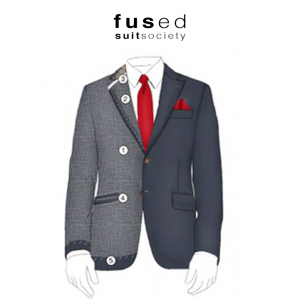What would you consider when selecting the perfect suit? How good it makes you look (the fit) is usually top of the list. Perhaps how nice it feels (the quality of the fabric) comes in a close second? However, unlike the fit and fabric quality, you may not even consider the construction of a suit. When it comes to determining the overall quality of a suit, construction plays a prominent role.
This week’s journal post gives gents a background on what construction options there are (fused vs. canvassed) exactly more on how to select the suit jacket construction — fused vs. canvassed and why it should matter to you. We’ll take something technical, simplify it and show you just how important understanding canvas construction is.

A properly constructed full-canvassed suit jacket is the best of the best. So, what exactly is it? A full canvased suit jacket is one that is constructed with canvas fabric spanning the entire inside front and lapels of the jacket. As a middle structural layer, the canvas is hand stitched to the fabric rather loosely (known as a “floating” canvas), so the garment moves with you. What results is a suit that drapes much more naturally, conforms to the body and looks better. Full-canvassed jackets are the most labour and time intensive, require a higher level of skill to make, and thus, tend to be more expensive. In return for the premium paid, you get a suit that not only moulds to you but will last the longest.
Pros:
- Conforms to your body and fits better over time.
- Gives your jacket body the most fluidity and support.
- No risk of de-lamination or bubbling.
Cons:
- More expensive to make = more expensive to buy. You might have to stay in a couple of Saturday nights to save up.

Unlike the full-canvassed jacket that has layers of canvassing stitched onto the wool shell, a fused jacket has a fusible interlining that’s glued to the wool shell of the suit – both in the front panels and in the lapels. Fusing the jacket gives the jacket shape, but isn’t hand stitched to the fabric, so may lack the nice, natural drape of canvassed jackets.
Its construction is not only quick, improvements in fusing technology has made this construction type a feasible option for the everyday gentleman at a much cheaper price.
Pros:
- Inexpensive compared to canvassed jackets.
- Continually improving fuse technology.
Cons:
- Stiff lapels on a stiff suit lacking the fluidity of a canvassed suit.
- Not as resilient and tend to wear quicker than a canvassed suit.
- Risk of de-lamination or bubbling.

Put simply, a half-canvassed suit jacket has elements of both a full-canvassed and fused jacket. A half-canvassed suit jacket has a thin layer of fusible throughout the front panel of the jacket; on top of this layer of fusible, the front panel has a layer of canvassing stitched on that extends from the shoulder down through the chest.
So, basically, what this means is that you get the benefits of the natural drape and shape that canvas provides where the suit needs it the most – the chest and the lapel. At the same time, you enjoy some cost savings in terms of materials and labour. Definitely a less expensive route to take than a fully-canvassed jacket, but a slightly stiffer finish.
Pros:
- The major benefits you’d get from a full-canvassed suit jacket can be had here:
- Good drape and shape in the chest.
- Nice lapel roll.
- Usually less expensive than a full-canvassed suit jacket.
Cons:
- Stiffer than a full-canvassed jacket.
- Some risk of de-lamination or bubbling.
Like all things in life, quality starts from the inside out – for this reason alone don’t underestimate the importance of your suit’s construction.
Carry on Gentlemen.
Suit Society






